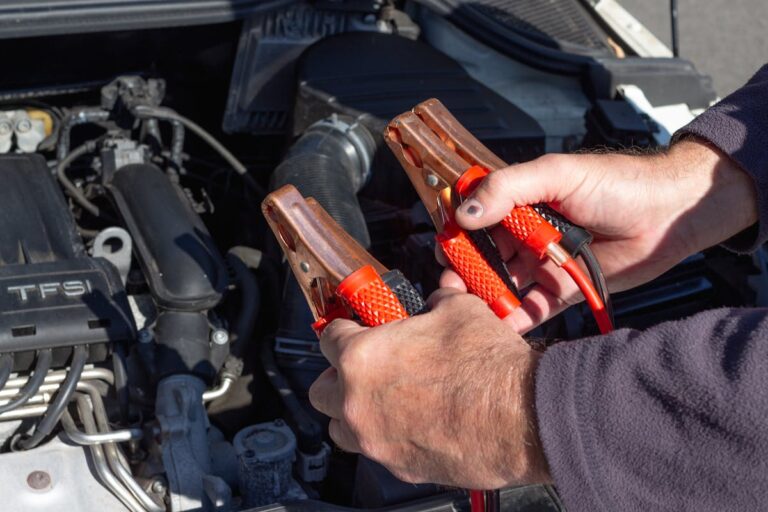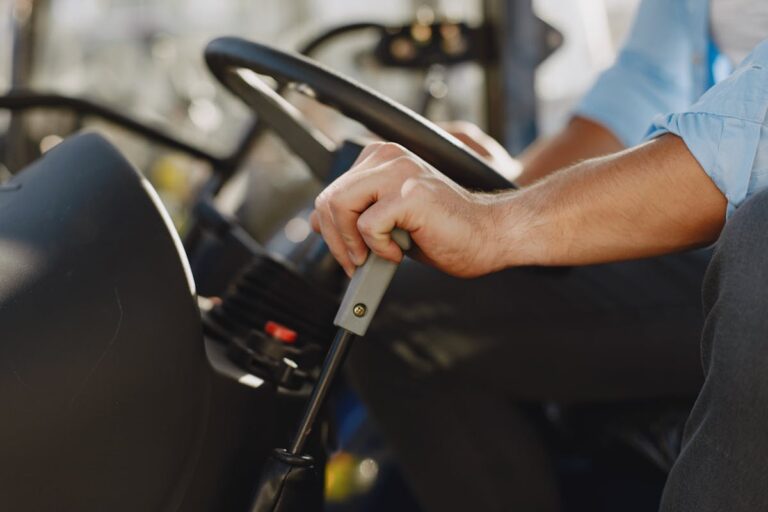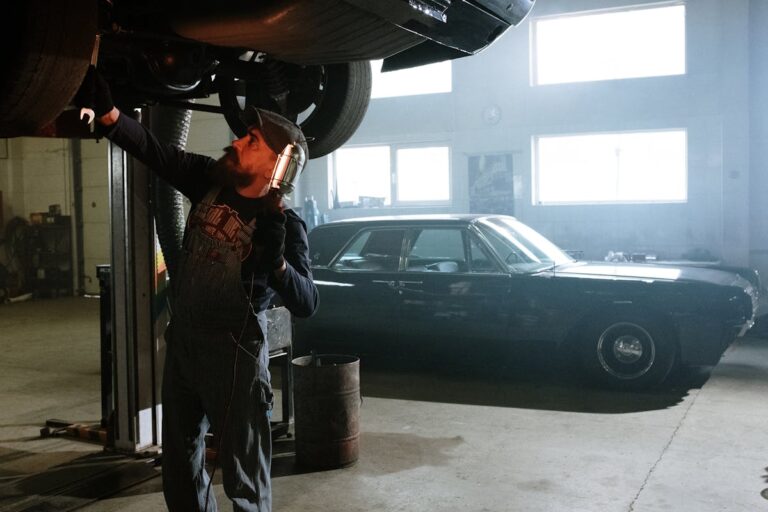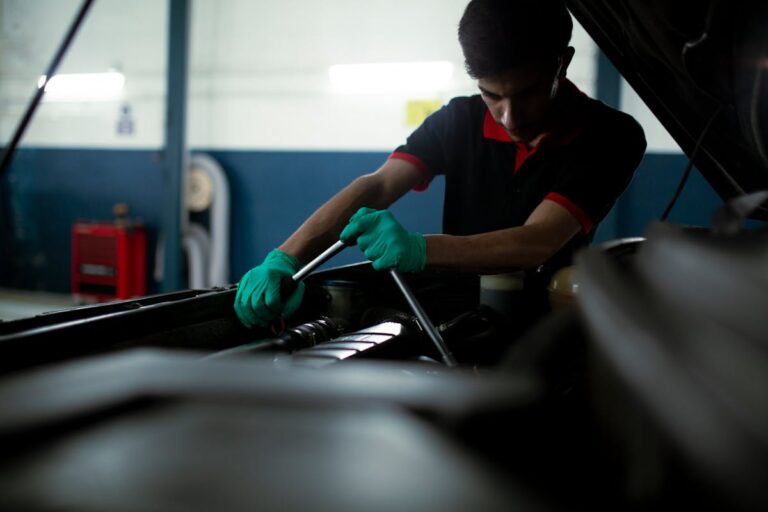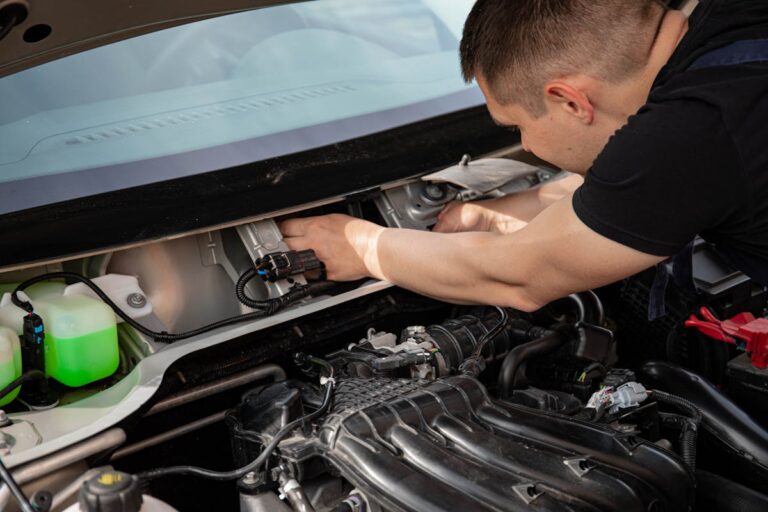Setting out on a road trip requires more than simply packing the car; it necessitates meticulous preparation of your vehicle to guarantee safety and prevent unforeseen breakdowns. A thorough check of the car’s crucial components such as fluid levels, tire pressure, brake efficiency, and the condition of the battery is critical. Furthermore, creating an emergency kit with essential tools and spare parts is a prudent step. However, the question arises, what specific checks should one perform on these components and what should be included in an emergency kit? The answer requires a deeper exploration into the domain of automotive maintenance.
Checking Your Car’s Fluid Levels
Before starting on a long journey, it is imperative to check your car’s fluid levels. This guarantees the ideal performance of your vehicle, reducing the risk of unforeseen mechanical issues that can cause delays or endanger your safety. There are two significant fluids to examine: coolant and oil.
The coolant level is essential to your engine’s health. Low coolant levels can result in your engine overheating, leading to severe damage. Check the coolant reservoir located under the hood; the fluid level should be between the minimum and maximum markers. Do this inspection when the engine is cool to avoid injury from steam or hot fluid.
Oil viscosity, on the other hand, indicates the thickness and flow of your oil. Oil with the right viscosity is critical for lubricating the engine’s moving parts. Checking oil viscosity involves pulling out the oil dipstick, wiping it clean, reinserting it, and then removing it again to check the oil’s level and color. It should be within the indicated markers and in a clear, amber color. Dark, dirty oil or a level below the minimum marker indicates a need for an oil change.
Inspecting Your Vehicle’s Tires
Making sure your vehicle’s tires are in ideal condition is an important step in preparing for a road trip. The significance of this process cannot be overstated as the wellbeing of tires directly impacts the safety and performance of your vehicle. Two key aspects to monitor are tire pressure and tread depth.
Tire pressure is a critical factor that affects your car’s fuel efficiency, handling, and the overall lifespan of your tires. It is recommended to check the tire pressure when the tires are cold, as driving warms up the tires, which can lead to an inaccurate reading. Use a quality tire pressure gauge and verify that all the tires, including the spare one, are inflated to the vehicle manufacturer’s recommended PSI (pounds per square inch).
Tread depth, on the other hand, is the vertical measurement from the top of the tire tread rubber to the bottom of its deepest grooves. It is essential for maintaining grip, especially in wet conditions. To check tread depth, use a tread depth gauge or simply do the penny test. If the tread covers part of Lincoln’s head when a penny is inserted, your tires have adequate tread. Failure to maintain proper tread depth can lead to poor traction and increased risk of tire-related accidents.
Verifying Brake System Efficiency
The integrity of your vehicle’s brake system holds paramount importance when preparing for a road trip. A well-functioning brake system is essential to guarantee your safety on long journeys. Therefore, evaluating the brake system’s efficiency becomes an indispensable part of road trip preparation.
One of the significant checks is to inspect brake pad wear. The brake pads play a pivotal role in the braking system. Excessive use can lead to their wear and tear, impacting the overall performance of your brakes. Visually inspect the pads for any signs of thinning or damage. If the pad is less than 1/4 inch thick, it may need replacement.
Next, examine the brake fluid quality. Brake fluid should be clear or slightly yellowish. A dark color indicates contamination, requiring immediate replacement. Additionally, the fluid level should be between the “MIN” and “MAX” markings on the reservoir. Low levels may indicate a leak in the system, which needs to be addressed promptly.
Assessing Car Battery Condition
After you’ve securely evaluated the brake system, the car battery should be your next focal point. The importance of a healthy car battery cannot be overstated. It is responsible for supplying electrical power to various car components, starting the engine, and storing energy. Consequently, it is critical to assess its condition before initiating a long journey.
There are several battery maintenance tips to guarantee a reliable road trip. First, clean the battery terminals. Corrosion on these parts can impair the battery’s performance. Use a mixture of baking soda and water to clean them, followed by applying petroleum jelly to prevent future corrosion.
Battery testing methods help ascertain the battery’s health. A voltmeter can measure the battery voltage. A fully charged battery should read around 12.6 volts or higher. Anything less indicates the battery may not be holding a charge well. Alternatively, a load tester can also assess the battery’s condition under stress, mimicking the energy draw of starting an engine.
Additionally, note the battery’s age. Car batteries typically last 3-5 years. If your battery is nearing the end of this range, consider replacing it before your trip to avoid potential issues.
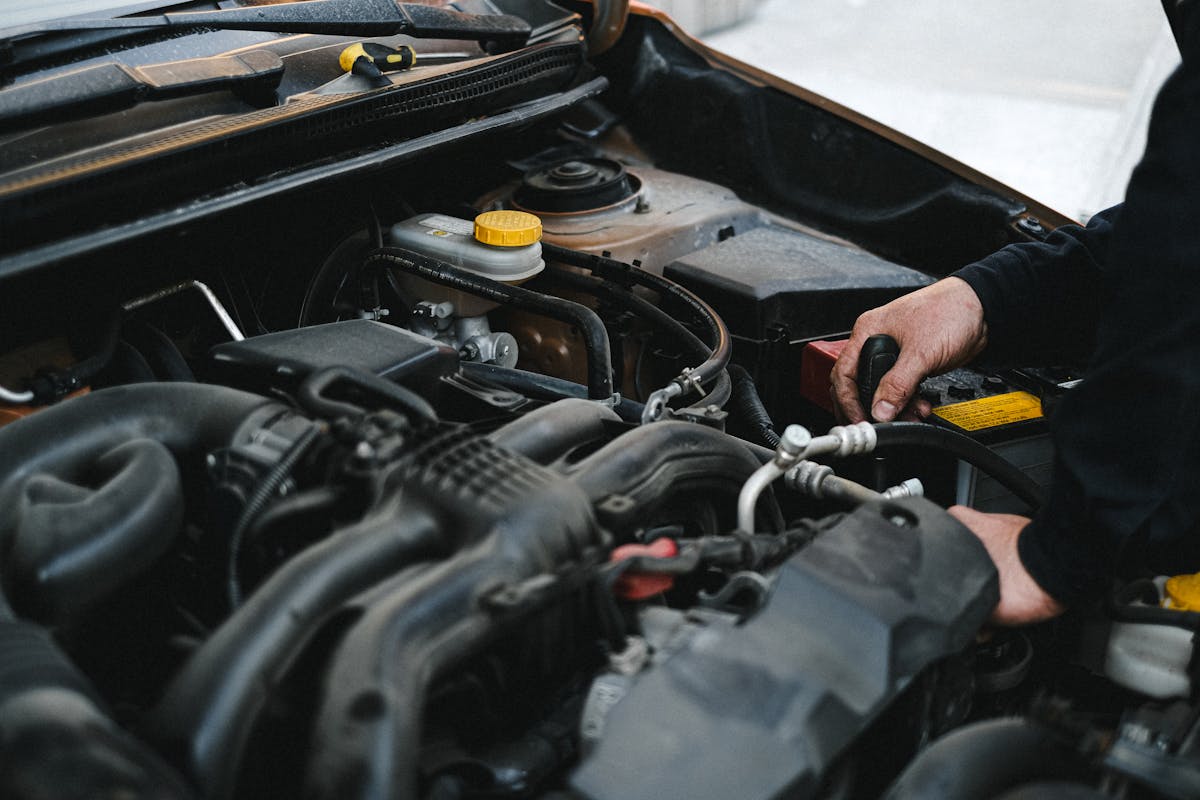
Ensuring Lighting System Functionality
Verifying the functionality of your car’s lighting system is an essential step in road trip preparation. The brightness of headlights should be checked for ideal visibility during night driving or in adverse weather conditions. Additionally, a thorough inspection of brake lights is necessary to guarantee safety signals are effectively communicated to other drivers on the road.
Checking Headlight Brightness
Before starting on a road trip, it’s vital to make certain that your car’s lighting system, especially the headlights, is functioning at its best. This check-up guarantees ideal visibility and safety on the road, particularly during nighttime or poor weather conditions.
An important part of this process involves checking the headlight alignment. Proper alignment enables the headlights to project light correctly onto the road, minimizing glare for oncoming drivers. To do this, park your car on a level surface about 10 feet away from a wall. The headlight beams should hit the wall at the correct spots, which is usually at or slightly below the headlight height. If the beams are misaligned, it’s recommended to have a professional adjust them.
Brightness testing is another significant aspect of confirming your headlights are in top condition. To test the brightness, simply switch on your headlights and observe if the light output is bright enough to illuminate the road ahead without straining your eyes. If the brightness is insufficient, it might be time to replace your headlight bulbs. Remember, dim headlights compromise your safety on the road, making it harder to spot potential hazards in time. Hence, it’s worth prioritizing this check before initiating your journey.
Brake Light Inspection
While the focus may often be on the headlights, the importance of fully functional brake lights cannot be overstated, particularly when commencing on a road trip. Brake lights alert the drivers behind you of your intention to slow down or stop, thereby playing a crucial role in preventing rear-end collisions. Understanding the brake light importance is essential for safe driving.
A brake light inspection should always be a part of your pre-road trip checklist. Begin by checking that each brake light is working perfectly. If one is out, it’s time for a brake light replacement. This is a simple task that you can do yourself, with many auto parts stores selling replacement bulbs and offering assistance with installation.
Next, check the brightness of the lights. If they seem dim or faded, it could be a sign of a weakening bulb or a dirty cover that needs cleaning.
Lastly, confirm that the brake lights respond instantly when you press the brake pedal. Any delay could indicate a problem with the wiring or the switch, necessitating professional intervention. Remember, a well-functioning lighting system is a key component to a safe and enjoyable road trip.
Preparing a Roadside Emergency Kit
An integral part of any road trip preparation is the assembly of a thorough roadside emergency kit. It is vital to identify essential items for the kit, which include tools, medical supplies, and survival items, to help mitigate any unforeseen circumstances on the road. Additionally, organizing these items effectively within your kit guarantees accessibility and efficiency during high-stress situations.
Essential Items for Kit
Armed with a well-stocked roadside emergency kit, you can confidently set off on your road trip, ready to tackle unexpected situations that may arise. An adequately prepared kit will guarantee that you’re equipped to handle minor accidents or breakdowns, making your journey safer and more enjoyable.
There are several essential items that you should include in your roadside emergency kit:
- First Aid Kit: A basic first aid kit is vital. It should include bandages, antiseptic wipes, tweezers, medical tape, and pain relievers. These items can be handy to treat minor injuries while waiting for professional help, if needed.
- Travel Snacks: Pack high-energy, non-perishable travel snacks. These can act as a life-saver if you’re stranded for a prolonged period.
- Flashlight and Extra Batteries: These can be useful when dealing with breakdowns during the night or in poorly lit areas.
- Jumper Cables: Dead batteries are a common car problem. Having a set of jumper cables can get your vehicle back on the road in no time.
Organizing Your Emergency Kit
Having listed the necessary items for a roadside emergency kit, our focus now shifts to the organization of these essentials. Proper kit organization is not merely about packing items in a bag; it involves strategic placement of your emergency supplies for easy and quick access during unforeseen circumstances.
Firstly, prioritize your items based on their frequency of use. Everyday tools like a flashlight, multi-tool, and first-aid supplies should be easily reachable. Nested within these layers should be less frequently used items, such as jumper cables and a tow rope.
Next, consider the size and shape of each item. Smaller items should be grouped and stored in a separate compartment or zip-lock bag to prevent them from scattering inside the kit. Larger items like bottled water and a fire extinguisher should be stored in the bottom for stability.
Finally, make certain that your emergency supplies are stored in a sturdy, waterproof container. This will not only keep your items organized and protected but will also allow for easy transfer in case you need to change vehicles.
Packing Essential Tools and Spares
Before commencing a long journey, one cannot overlook the importance of packing essential tools and spares for the car. This task guarantees that you are prepared to handle minor mechanical issues that could potentially interrupt your journey. A well-organized packing checklist, coupled with effective tool organization, plays a significant role in this preparation.
An ideal set of tools and spares should include the following:
- A spare tire, along with a jack and tire iron
- Basic tools such as a wrench, screwdriver and pliers
- Essential fluids including motor oil, coolant, and windshield wiper fluid
- Jumper cables
The spare tire, jack and tire iron are indispensable for handling flat tires on the road. Basic tools can aid in tightening loose parts or making minor repairs. Maintaining a supply of essential fluids helps keep the car running smoothly, and jumper cables are critical for dealing with a dead battery.
Proper tool organization not only makes it easier to locate these items when they are needed but also optimizes space utilization in your car. Consequently, packing essential tools and spares is essential to guaranteeing a smooth and enjoyable road trip.
Frequently Asked Questions
What Food and Drinks Should I Pack for a Long Road Trip?
For a long road trip, consider packing a variety of snack options such as fruits, nuts, and protein bars. For drink choices, water, sports drinks, and non-perishable milk or juice boxes are advisable.
How Often Should I Schedule Rest Stops During a Road Trip?
Rest stop frequency during a road trip should ideally be every two hours or 100 miles, according to health considerations. Regular breaks can prevent driver fatigue, promote good circulation, and maintain overall well-being during your journey.
What Are the Best Navigation Apps for Road Trips?
The best navigation apps for road trips offer GPS alternatives and offline maps. Examples include Google Maps for thorough, reliable directions, Waze for real-time traffic updates, and Maps.me for extensive offline navigation capabilities.
How to Keep Kids Entertained During a Long Car Journey?
To keep children entertained during a lengthy car journey, consider incorporating road trip games and utilizing audio books. These interactive methods can sustain interest, stimulate imagination, and make travel time enjoyable for young passengers.
What Should I Consider When Choosing Overnight Accommodations on a Road Trip?
When selecting overnight accommodations for a road trip, consider the price range, location convenience, amenities offered, and cancellation policies. Additionally, scrutinize guest reviews and check pet policies if traveling with animals.
